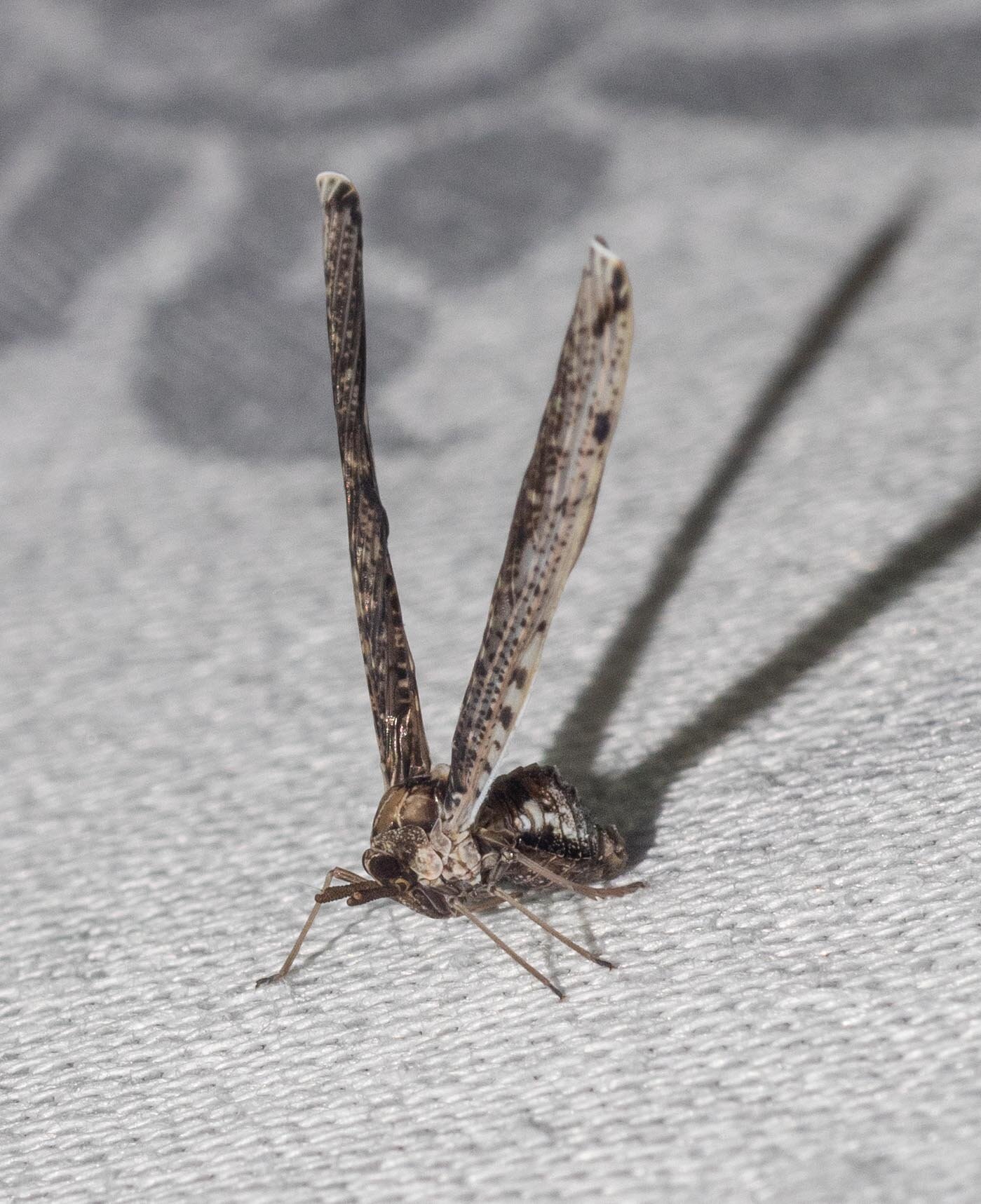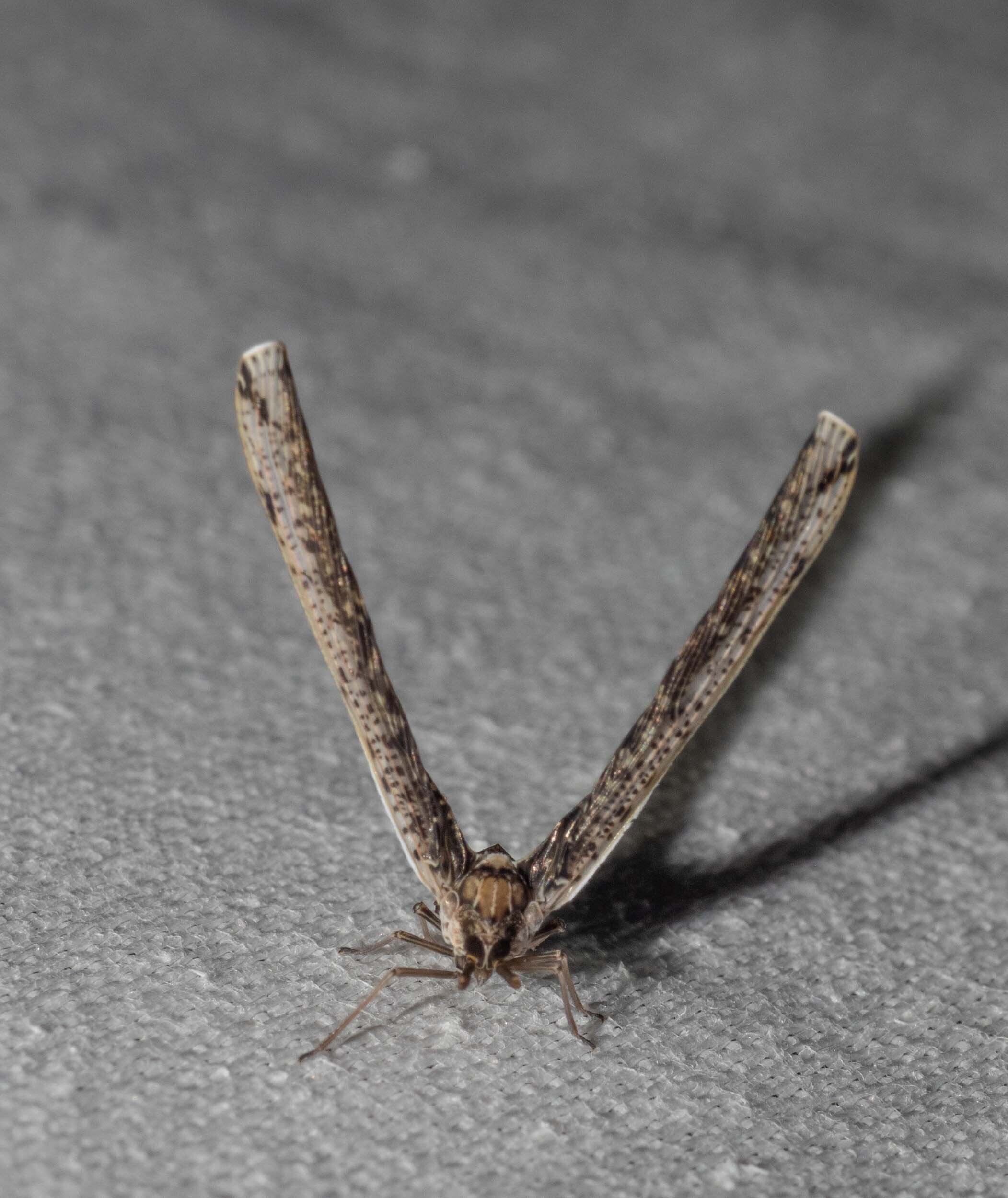Hemiptera; Derbidae; Zoraida sp.

Workbook
We found a peculiar insect on the moth lightsheet of 15/16 March, 2021.
Kerri identified this insect as a hemipteran in the family Derbidae, genus Zoraida, using photos on iNaturalist that showed its long, narrow wings.
The diagnostic criteria for sub-family Zoraidinae according to the key in Muir, F. (1918) Entomologist’s Monthly Magazine 54: 173-177 are:
tegmina long and narrow
wings very small or not more than half the length of the tegmina, narrow
Our insect matches these sub-family criteria and appears to match the following criteria for the genus Zoraida and subgenus Zoraida (to which all known Australian species belong):
eyes in front not reaching to the base of the clypeus; subcostal cell long, sometimes very narrow (figs 1, 6)
antennae as long as face or longer, cylindrical (figs 4, 5)
4 cubital veins reaching the hind margin of tegmina
vertex not broader than wide; face narrow, round in profile, not produced conically (figs 5, 6)
hind margin of tegmen not angularly produced between the apex of the clavus and cubital veins
costal margin not produced on basal fourth
hind margin of pronotum angularly emarginate (figs. 2, 3)
In addition, it matches the overall appearance of a Zoraida sp. shown in Insects of Australia.
Zoraida sp. Fig. 30.41E from The Insects of Australia 2nd Ed. MUP 1991.
AFD lists 6 Australian Zoraida - Z. consanguinea, Z. cycnoptera, Z. essingtonii, Z. eupoecila, Z. picta and Z. sexnotata. All of these were described from specimens collected in Far North Queensland and Torres Strait.
The original descriptions of these species in Distant, 1907 and Westwood, 1851, listed below use colouration of the body and wings as the main diagnostic features.
My species differs from each of these previously described species in one or more respects - indicated in bold for each species.
Z. essingtonii - yellow-coloured pronotum with granular white sides; three narrow, white carinae on the mesonotum; white scutellum, white tarsi; intermediate abdominal segments with granular white bumps; tegmina whitish-brown; costa with a large white point at the anterior apex and an oblique brown spot at the apex; reddish granular antennae.
Z. cycnoptera - straw-coloured pronotum, scutellum, ventral body and legs; anterior side of abdomen, posterior disk of pronotum, vertex of head, face and clypeus testaceous (reddish-brick colour); tegmina hyaline, venation fuscous (brownish-grey), costal area for about one third from the base fuscous brown, with creamy-white spots, the remaining area ochraceous (yellow with slight tinge of brown) with a prominent black spot before apex, costal and subcostal veins testaceous red, upper apical area pitch coloured, apical margin and extremiites of apical veins testaceous red in male, in female two central extremities straw-coloured; wings hyaline, venation fuscous; mesonotum tricarinate with central carination continued through pronotum; clypeus centrally and laterally carinate; length of body 4.5 male, 6mm female; length including tegmen male 24mm, female 30mm.
Z. eupoecila - Head, antennae, pronotum, mesonotum, scutellum and abdomen tawny brown; sternum and legs stramineous; carinations to pronotum and mesonotum distinctly paler and pale ochraceous in hue; eyes black; tegmina very pale fuliginous, subhyaline, infuscated on basal area, where there is a distinct white spot beneath radial area, veins fuscous, costal area greyish white, with an elongate fuscous spot near middle and another nearer apical area; beneath the costal area the colour is narrowly fuscous, broken with a large creamy-white spot just before the second dark spot in costal area, costal margin at apex testaceous, and the apical margin creamy white, before the latter a transverse series of four small fuscous spots placed on the veins, a large fuscous spot at end of clavus; wings very pale fuliginous, with the veins fuscous; second joint of antennae robust, as long as head and thorax together. Long., excl. tegm., 5 mm; exp. tegm. 22 mm
Z. consanguinea - Allied to Z. eupoecila, and differing principally by the tegmina, which are very much more broadly and regularly fuscous beneath the costal area, the latter creamy white, with three elongate fuscous spots on basal third, subapical transverse spots obsolete, veins to discoidal areas more transversely and less longitudinally oblique. Long., excl. tegm., 4 mm; exp. tegm. 18–23 mm (Distant 1907)
Z. sexnota (cydista) - Testaceous, whitish yellow beneath. Vertex and front extremely narrow, forming a keel between the eyes. Antennae pale testaceous. Hind part of the thorax whitish. Abdomen with a black stripe along each side, bright red at the tip and with a bright red band near the base. Legs whitish yellow. Wings pellucid; veins black. Fore wings with three brown subcostal spots and three brown apical spots; transverse veins hardly clouded with brown; costa bright red. Hind wings about one-third of the length of the fore wings. Length of the body 3mm, of the wings 19-21 mm (Walker 1870).
Z. picta - Above and beneath pale ochraceous; eyes black; pronotum stramineous; abdomen above with angulate fasciate sanguineous markings and with a curved black discal line on each side a little beyond middle; tegmina hyaline, the veins fuscous, costal area pale testaceous, an oblique black spot in subcostal area at about two thirds from base and a black spot at its apex, the veins emanating from the subcostal vein black at their bases; mesonotum faintly tricarinate; second joint of antennae minutely black-speckled, with its apex darker ochraceous, as long as head and thorax together. Long., excl. tegm., 4.5 mm; exp. tegm. 21 mm
This is a workbook page … a part of our website where we record the observations and references used in making species identifications. The notes will not necessarily be complete. They are a record for our own use, but we are happy to share this information with others.







